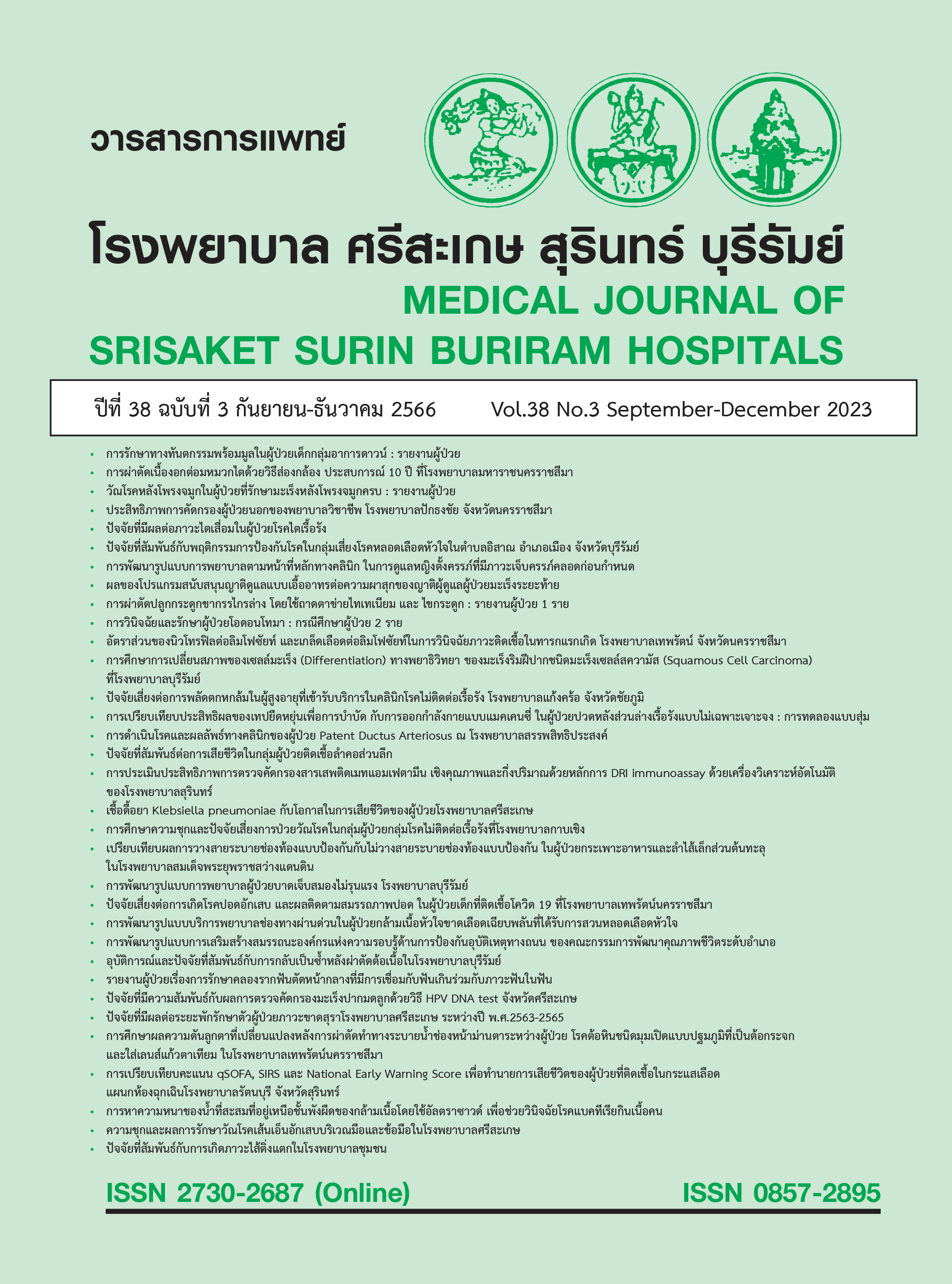การวินิจฉัยและรักษาผู้ป่วยโอดอนโทมา : กรณีศึกษาผู้ป่วย 2 ราย
Main Article Content
บทคัดย่อ
หลักการและเหตุผล: โอดอนโทมา เป็นเนื้องอกต้นกำเนิดจากฟันชนิดไม่ร้ายแรงซึ่งพบมากทั่วโลก สัมพันธ์กับการมีฟันน้ำนมคงค้างและฟันถาวรที่ถูกขัดขวางการขึ้นมาในช่องปาก เนื่องจากไม่มีอาการ ผู้ป่วยจึงมักจะได้รับการวินิจฉัยในระหว่างการตรวจสุขภาพช่องปาก การตรวจพบเนื้องอกนี้แต่แรกเริ่มเป็นสิ่งจําเป็น เพื่อหลีกเลี่ยงการรักษาแก้ไขความผิดปกติการสบฟันที่ยาวนานและยุ่งยากซับซ้อนมากขึ้น
วิธีการศึกษา: การศึกษารายกรณี (Case study) โดยการทบทวนเวชระเบียนผู้ป่วยซึ่งเก็บข้อมูลอาการ อาการแสดง ผลการตรวจทางรังสีวิทยาและการตรวจชิ้นเนื้อทางจุลพยาธิวิทยา การรักษาและการติดตามผล
ผลการศึกษา: กรณีศึกษาผู้ป่วยรายที่ 1 หญิงไทยอายุ 22 ปี ตรวจสุขภาพช่องปากเพื่อจัดฟัน พบฟันตัดข้างและฟันเขี้ยวน้ำนมคงค้าง ร่วมกับเนื้องอกโอดอนโทมา ฟันตัดข้างและฟันเขี้ยวถาวรบนขวาที่ยังไม่ขึ้น ผู้ป่วยรายที่ 2 เด็กชายอายุเก้าขวบรายงานว่าตรวจสุขภาพฟัน พบโอดอนโทมาร่วมกับฟันเขี้ยวถาวรล่างซ้ายและฟันกรามน้อยซี่ที่หนึ่ง ที่ยังไม่ขึ้น ลักษณะทางคลินิก ภาพถ่ายรังสี และจุลพยาธิวิทยาของรอยโรคในผู้ป่วยทั้ง 2 รายนี้สอดคล้องกับการศึกษาที่เคยมีมาจากการทบทวนวรรณกรรม การรักษาทางศัลยกรรม ได้ผลการรักษาเป็นที่น่าพอใจ โดยมีหนึ่งรายที่ต้องส่งต่อเพื่อรับการรักษาทางทันตกรรมจัดฟันต่อ เพื่อดึงฟันถาวรคุดขึ้นสู่ตำแหน่งในช่องปาก
สรุป: โอดอนโทมา เป็นเนื้องอกชนิดไม่ร้ายแรงที่มีกำเนิดจากฟัน ซึ่งอาจไปมีผลรบกวนการขึ้นของฟัน ทำให้ฟันขึ้นช้า หรือไม่สามารถขึ้นมาในช่องปากได้ตามปกติ การตรวจวินิฉัยโอดอนโทมาได้อย่างรวดเร็วและรักษาใน
Article Details

อนุญาตภายใต้เงื่อนไข Creative Commons Attribution-NonCommercial-NoDerivatives 4.0 International License.
เอกสารอ้างอิง
Speight PM, Takata T. New tumour entities in the 4th edition of the World Health Organization Classification of Head and Neck tumours: odontogenic and maxillofacial bone tumours. Virchows Arch 2018;472(3):331-9. doi: 10.1007/s00428-017-2182-3.
Neville BW, Damm DD, Allen CM, Chi AC. Oral and maxillofacial pathology. 4th.ed. St. Louis, MO : Elsevier ; 2016 : 674-5.
Ebenezer V, Ramalingam B. A cross-sectional survey of prevalence of odontogenic tumours. J Maxillofac Oral Surg 2010;9(4):369-74. doi: 10.1007/s12663-011-0170-8.
Buchner A, Merrell PW, Carpenter WM. Relative frequency of central odontogenic tumors: a study of 1,088 cases from Northern California and comparison to studies from other parts of the world. J Oral Maxillofac Surg 2006;64(9):1343-52. doi: 10.1016/j.joms.2006.05.019.
Lapthanasupkul P, Juengsomjit R, Klanrit P, Taweechaisupapong S, Poomsawat S. Oral and maxillofacial lesions in a Thai pediatric population: a retrospective review from two dental schools. J Med Assoc Thai 2015;98(3):291-7.PMID: 25920300
Taweevisit M, Tantidolthanes W, Keelawat S, Thorner PS. Paediatric oral pathology in Thailand: a 15-year retrospective review from a medical teaching hospital. Int Dent J 2018;68(4):227-34. doi: 10.1111/idj.12380
An SY, An CH, Choi KS. Odontoma: a retrospective study of 73 cases. Imaging Sci Dent 2012;42(2):77-81. doi: 10.5624/isd.2012.42.2.77.
Hidalgo-Sánchez O, Leco-Berrocal MI, Martínez-González JM. Metaanalysis of the epidemiology and clinical manifestations of odontomas. Med Oral Patol Oral Cir Bucal 2008;13(11):E730-4. PMID: 18978716
Yildirim-Oz G, Tosun G, Kiziloglu D, Durmuş E, Sener Y. An unusual association of odontomas with primary teeth. Eur J Dent 2007;1(1):45-9. PMID: 19212497
Teruhisa U, Murakami J, Hisatomi M, Yanagi Y, Asaumi J. A case of unerupted lower primary second molar associated with compound odontoma. Open Dent J 2009;3:173-6. doi: 10.2174/1874210600903010173.
Saravanan R, Sathyasree V, Manikandhan R, Deepshika S, Muthu K. Sequential Removal of a Large Odontoma in the Angle of the Mandible. Ann Maxillofac Surg 2019;9(2):429-33. doi: 10.4103/ams.ams_102_19.
Bagewadi SB, Kukreja R, Suma GN, Yadav B, Sharma H. Unusually large erupted complex odontoma: A rare case report. Imaging Sci Dent 2015;45(1):49-54. doi: 10.5624/isd.2015.45.1.49.
Bereket C, Çakır-Özkan N, Şener İ, Bulut E, Tek M. Complex and compound odontomas: Analysis of 69 cases and a rare case of erupted compound odontoma. Niger J Clin Pract 2015;18(6):726-30. doi: 10.4103/1119-3077.154209.
Marcarini KNO, Gabriela DE OB, Rodrigues BL, Bertollo RM Venancio, Martha AALS, et al. Erupted odontoma associated with impacted teeth-case report. Oral Surg Oral Med Oral Radiol 2020;129(1): e115. https://doi.org/10.1016/j.oooo.2019.06.494
Kaczor-Urbanowicz K, Zadurska M, Czochrowska E. Impacted Teeth: An Interdisciplinary Perspective. Adv Clin Exp Med 2016;25(3):575-85. doi: 10.17219/acem/37451.
Tomizawa M, Otsuka Y, Noda T. Clinical observations of odontomas in Japanese children: 39 cases including one recurrent case. Int J Paediatr Dent 2005;15(1):37-43. doi: 10.1111/j.1365-263X.2005.00607.x.
Teruhisa U, Murakami J, Hisatomi M, Yanagi Y, Asaumi J. A case of unerupted lower primary second molar associated with compound odontoma. Open Dent J 2009;3:173-6. doi: 10.2174/1874210600903010173.
Hatziemmanuil D, Zouloumis L, Topouzelis N. Surgical and orthodontic management of anterior impacted teeth. Balk J Stom 2006;10(2):79-88.
de Oliveira BH, Campos V, Marçal S. Compound odontoma--diagnosis and treatment: three case reports. Pediatr Dent 2001;23(2):151-7. PMID: 11340730
American Academy of Pediatric Dentistry. Prescribing dental radiographs for infants, children, adolescents, and individuals with special health care needs. The Reference Manual of Pediatric Dentistry. Chicago, Ill. : American Academy of Pediatric Dentistry ; 2022:273-6.


